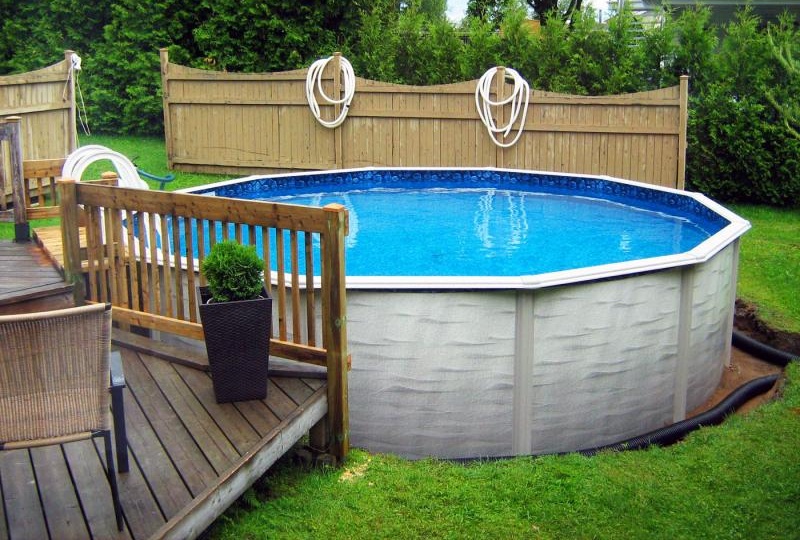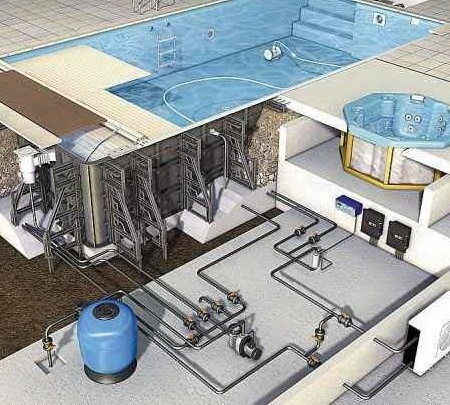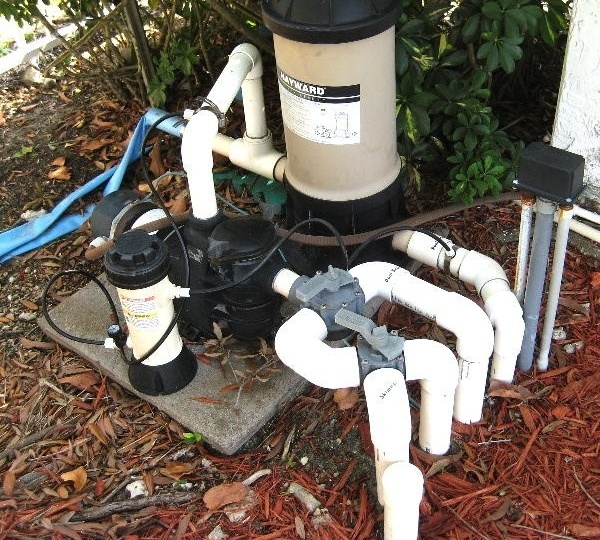Waterproofing the pool: a comparative overview of waterproofing materials
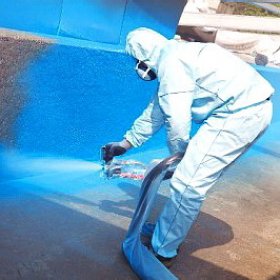
Most owners of their own houses, whether it be cottages or small cottages, dream of building a pool on their site. Many bring their dreams to life. The work on arranging your own small reservoir is quite simple and can be done independently. So that the new pool only pleases its owner, during its construction, special attention should be paid to effective waterproofing. The bowl experiences significant loads created by water, and without special protection very quickly fails. How to properly perform waterproofing work? We'll figure out.
Content
Internal or external waterproofing - which is better?
There are two types of pool waterproofing: external and internal. The first applies only if the structure is threatened by groundwater, which happens infrequently. In most cases, pools are installed above the level of subsurface water and external waterproofing is not required. It is equipped only when direct contact of groundwater and the bowl is assumed.
External protection is especially relevant for concrete structures. Porous material easily absorbs moisture, which destroys metal fittings, internal waterproofing and deforms the pool. In this case, the most effective way of external protection against water will be the installation of bentonite mats, which are made on the basis of clays of natural origin.
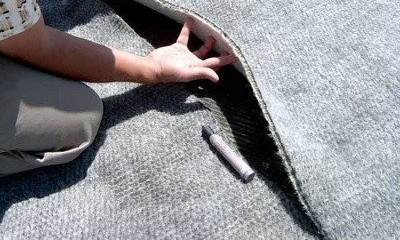
Bentonite mats are the best choice for external waterproofing of the pool. They perfectly protect the surface of the structure from groundwater
Internal waterproofing is necessary for any type of bowl. It will protect the pool from the damaging effects of moisture, prevent leaks and become an obstacle to corrosion. High-quality insulation must meet the following requirements:
- Resistance to cracking and tearing up to 3 mm.
- Small width and elasticity of the waterproofing layer.
- High adhesion to the surface.
- Good water resistance.
- The ability to withstand dynamic and hydrostatic loads.
- Compliance with environmental standards.
- Suppression of the activity of microorganisms.
It is also very important to note that the insulation you choose must match the type of finish.
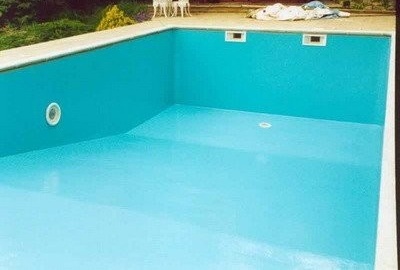
High-quality waterproofing protects the bowl from the damaging effects of moisture and extends the life of the pool
Popular insulation materials
High-quality waterproofing of the pool can be carried out in several ways.All of them have certain advantages and disadvantages. To choose the best option you need to get acquainted with each of them.
Option # 1 - cement based materials
As insulation materials based on a cement-sand mixture are used. Most often, these are two-component film polymer-cement compositions based on vinyl acetate and synthetic resin. The advantages of insulation include:
- High strength and reliability, allowing the material to withstand dynamic and static loads.
- Good adhesion to various surfaces.
- Long service life and maintainability.
- Good vapor permeability, which solves the problem of the formation of unwanted bubbles and swelling on the surface.
- Ecological purity of the material.
- Possibility of application on wet surfaces.
The biggest drawback of the material is low elasticity, which makes the compositions ineffective in areas of stress concentration. Therefore, they are used in combination with more elastic sealants, which insulate and embroider joints, seams and similar sections. They become additional unloading belts. An important feature of cement-based insulating compounds is the ability to combine the functions of waterproofing and tile adhesive.
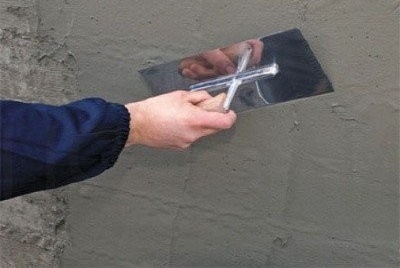
Low elasticity and insufficient resistance to dynamic and hydrostatic loads are the main disadvantages of cement-based waterproofing
Option # 2 - Penetration Insulation for Concrete Bowls
The composition of the materials includes chemically active compounds, including modifiers, which, when hit on a concrete surface, begin to spread very quickly through the pores. After solidification, water-insoluble crystals are formed that completely fill the pores, microscopic cracks and other cavities.
The advantages of penetrating materials are:
- Vapor permeability allowing concrete to "breathe".
- Good adhesion to the base.
- Continuous, seamless layer of isolation.
- Resistance to aggressive environments.
- The ability to apply the composition on the surface of any form, even very complex.
- Long term of operation.
- Prevention of mold and mildew.
- Possibility of application on a damp base.
The insulation forms a good base for the plaster. The disadvantages of the material include the lack of the possibility of applying the composition to the connection areas of concrete and water supply equipment elements.
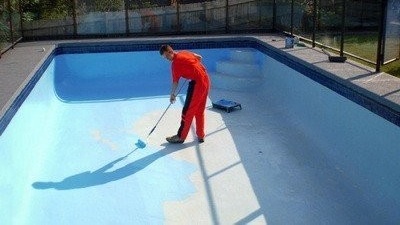
The active compound penetrates deep into the pores of the base and, after solidification, forms crystals that tightly clog all cavities
Option # 3 - PVC insulating film
There are three varieties of insulation material. The most budget option - unreinforced film. It has the lowest strength and is most often used for prefabricated pools. Reinforced material is more durable because it is reinforced with polyester threads. Able to withstand quite large loads without deformation. On sale you can find anti-slip film, which eliminates the sliding surface of the pool. The best option can be considered an acrylic-coated material that prevents the growth of microorganisms and prevents fading.

PVC film acts as a waterproofing and at the same time finishing the bowl. You can choose a plain material or find a coating that imitates stone, mosaic, etc.
The advantages of film insulation are:
- The ability to simultaneously act as a decorative coating and waterproofing.
- High frost resistance and resistance to aggressive environments.
- Low cost.
- Hygiene coating.
- Possibility of use both in the construction and reconstruction of pools. Material can be laid on top of old finishes, such as tiles.
- A variety of colors and finishes. You can choose a monophonic film or a material that imitates a mosaic, stone, etc.
The main disadvantage of the material is its relatively short life. It is only 5-10 years old. Over time, the film surface becomes scratched and the color intensity is lost. Another drawback is the rather laborious installation. Most often it is carried out by professionals, since it involves the use of sophisticated technologies, for example, welding joints with hot air. The slightest mistake will cause moisture to enter under the waterproofing carpet.
Option # 4 - Liquid Rubber
The material is a bitumen-polymer water elastomeric emulsion. The solution is applied by spraying using a catalyst, which allows you to run a quick reaction of the decay of the emulsion. As a result, water is pushed out of the composition, and the dry residue forms a waterproofing membrane.
The advantages of liquid rubber can be considered:
- Resistance to various aggressive environments.
- The formation of a seamless continuous membrane, the thickness of which can be adjusted during the spraying process.
- High strength and reliability, long service life.
- Possibility of applying to the surface of any configuration.
- Full waterproof.
- The material does not emit toxic substances. It is safe for humans.
- The ability to add the desired pigment to the solution, which allows you to get the coating of the desired shade.
A serious drawback of liquid rubber is its instability to UV radiation. The material must be coated with special UV protection agents. For coating, special equipment is used that only specialists can work with. In addition, thorough application of the substrate is required before applying liquid rubber.
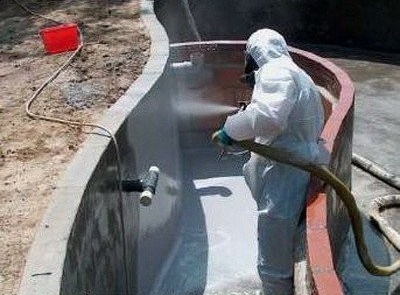
Liquid rubber is applied by spraying using special equipment. The procedure is performed only by a specialist.
Option # 5 - liquid glass
This is an aqueous solution with sodium silicate, which fills all the pores and microcracks of the base well. The material is considered an excellent sealant, its crystalline structure provides reliable protection against moisture. It can also be used as additives, impregnations and additives. The advantages of the coating include:
- Formation of a waterproof barrier.
- Easy to use.
- Antiseptic properties that prevent the growth of microorganisms.
- High fire resistance.
- Reliable grip.
- Frost resistance.
- Low cost.
The disadvantage of liquid glass is fast crystallization. The prepared working solution must be laid in a very short time. That is why waterproofing work is best entrusted to a specialist. In addition, liquid glass is quickly destroyed. Without protection, its life will be only 5 years. To prevent this, it is recommended to cover the waterproofing with a protective layer of paint.
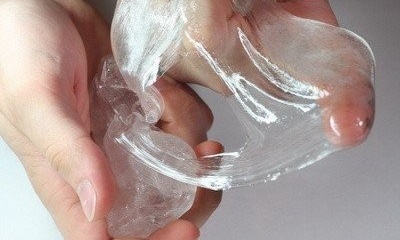
Liquid glass crystallizes very quickly, so it should be applied to the substrate almost immediately after preparation of the working solution
Option # 6 - latex membrane
It is a latex-based ready-to-use liquid. Complete with it is a special reinforcing fabric. The solution is applied to the abutment lines and corners that are glued with strips of fabric. Then the floor and walls of the pool are covered with a composition, on top of which the canvas is laid. In conclusion, everything is again covered with a layer of solution. After complete drying, a protective membrane forms on the surface of the bowl. Advantages of latex waterproofing:
- It forms a thin, waterproof, elastic, crack-suppressing coating.
- Suppresses the growth of microorganisms.
- The material easily overlaps plastic inserts and cold seams.
- It has high strength and long life.
The disadvantages of the coating are the high cost and complexity of application. Do not lay the membrane on a damp surface.
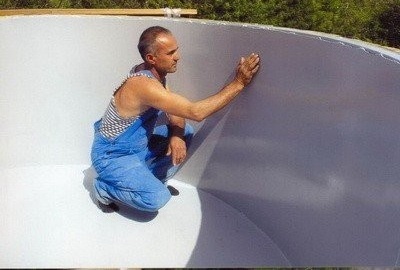
The latex membrane is a liquid solution complete with a special reinforced fabric. The material provides an elastic, strong and durable insulating coating.
Which option to give preference?
Choosing waterproofing materials for your pool, it is worth listening to the opinion of experts. They believe that penetrating and cement waterproofing, which are characterized by low elasticity, are not resistant to crack opening and do not withstand strong dynamic and hydrostatic loads, are the least optimal for insulating work. The best result will be the use of liquid rubber, PVC film or a waterproofing membrane. These materials meet all modern requirements and provide the pool with the most effective waterproofing.
